Study on Establishing Degradation Model of Chip Solder Joint Material under Coupled Stress
Abstract
1. Introduction
2. Degradation Tests under Coupled Stress
2.1. Test Design
2.2. Micro Analysis of Failure Samples
2.3. Finite Element Simulation
3. Characterization of Solder Joint Degradation
3.1. PCMD Health Index
3.2. Division of Degradation Stage
4. Degradation Modeling Based on Failure Physics
4.1. Modeling of Strain Accumulation Stage
4.2. Modeling of Crack Propagation Stage
4.3. Model Verification and Error Discussion
5. Conclusions
Author Contributions
Funding
Acknowledgments
Conflicts of Interest
References
- Changhua, H.; Hong, P.; Zhaoqiang, W.; Xiaosheng, S.; Zhengxin, Z. A new remaining useful life estimation method for equipment subjected to intervention of imperfect maintenance activities. Chin. J. Aeronaut. 2018, 31, 514–528. [Google Scholar]
- Jianzhong, S.; Chaoyi, L.; Cui, L.; Ziwei, G.; Ronghui, W. A data-driven health indicator extraction method for aircraft air conditioning system health monitoring. Chin. J. Aeronaut. 2019, 32, 409–416. [Google Scholar]
- Sankavaram, C.; Pattipati, B.; Kodali, A.; Pattipati, K.; Azam, M.; Kumar, S.; Pecht, M. Model-based and data-driven prognosis of automotive and electronic systems. In Proceedings of the 2009 IEEE International Conference on Automation Science and Engineering, Bangalore, India, 22–25 August 2009; pp. 96–101. [Google Scholar]
- Barua, A.; Khorasani, K. Hierarchical fault diagnosis and health monitoring in satellites formation flight. Ieee Trans. Syst. Man Cybern. Part C (Appl. Rev.) 2010, 41, 223–239. [Google Scholar] [CrossRef]
- Han, Z.J.; Xue, S.B.; Wang, J.X.; Zhang, X.; Zhang, L.; Yu, S.L.; Wang, H. Mechanical properties of QFP micro-joints soldered with lead-free solders using diode laser soldering technology. Trans. Nonferrous Met. Soc. China 2008, 18, 814–818. [Google Scholar] [CrossRef]
- Zhou, X.; Lu, X.; Cao, X.; Liu, Z.; Chen, Y. Research on life evaluation method of solder joint based on eddy current pulse thermography. Rev. Sci. Instrum. 2019, 90, 084901. [Google Scholar] [CrossRef]
- Pecht, M.; Jaai, R. A prognostics and health management roadmap for information and electronics-rich systems. Microelectron. Reliab. 2010, 50, 317–323. [Google Scholar] [CrossRef]
- Wang, N.; Ma, X.; Xu, X.; Rui, Z. A Low Power Online Test Method for FPGA Single Solder Joint Resistance. J. Electron. Test. 2017, 33, 775–780. [Google Scholar] [CrossRef]
- Wang, N.; Li, Y.; Yu, Z.; Ren, Z. Online test method of FPGA solder joint resistance withlow power consumption, Microelectron. Reliability 2015, 55, 1867–1871. [Google Scholar]
- Shao, J.; Zhang, H.; Chen, B. Experimental Study on the Reliability of PBGA Electronic Packaging under Shock Loading. Electronics 2019, 8, 279. [Google Scholar] [CrossRef]
- Tang, W.; Jing, B.; Huang, Y.F.; Sheng, R. Feature extraction for latent fault detection and failure modes classification of board-level package under vibration loadings. Sci. China Technol. Sci. 2015, 58, 1905–1914. [Google Scholar] [CrossRef]
- Che, F.X.; Pang, J.H. Study on reliability of PQFP assembly with lead free solder joints under random vibration test. Microelectron. Reliab. 2015, 55, 2769–2776. [Google Scholar] [CrossRef]
- Zhao, C.; Shen, C.; Hai, Z.; Zhang, J.; Bozack, M.J.; Evans, J.L. Long term aging effects on the reliability of lead free solder joints in ball grid array packages with various pitch sizes and ball alignments. In Proceedings of the SMTA International, Rosemont, IL, USA, 27 September–1 October 2015. [Google Scholar]
- Long, Y.; Luo, H.; Zhi, Y.; Wang, X. Remaining Useful Life Estimation of Solder joints using an ARMA Model Optimized by Genetic Algorithm. In Proceedings of the 2018 19th International Conference on Electronic Packaging Technology, Shanghai, China, 8–11 August 2018; pp. 1108–1111. [Google Scholar]
- Lee, C.; Kwon, D. A similarity based prognostics approach for real time health management of electronics using impedance analysis and SVM regression. Microelectron. Reliab. 2018, 83, 77–83. [Google Scholar] [CrossRef]
- Zhang, Q.K.; Zhang, Z.F. In Situ observations on creep fatigue fracture behavior of Sn–4Ag/Cu solder joints. Acta Mater. 2011, 59, 6017–6028. [Google Scholar] [CrossRef]
- Zhu, Y.; Li, X.; Wang, C.; Gao, R. Investigation on high temperature mechanical fatigue failure behavior of SnAgCu/Cu solder joint. J. Mater. Sci. Mater. Electron. 2014, 25, 1429–1434. [Google Scholar] [CrossRef]
- Huang, M.K.; Lee, C. Board level reliability of lead-free designs of BGAs, CSPs, QFPs and TSOPs. Solder. Surf. Mt. Technol. 2008, 20, 18–25. [Google Scholar] [CrossRef]
- Jiaxing, H.; Bo, J.; Zengjin, S.; Fang, L.; Yaoyun, C.; Yulin, Z. Failure and failure characterization of QFP package interconnect structure under random vibration condition. Microelectron. Reliab. 2018, 91, 120–127. [Google Scholar] [CrossRef]
- Frémond, M.; Nedjar, B. Damage, gradient of damage and priciple of virtual power. Intern. J. Solids Struct. 1996, 33, 1083–1103. [Google Scholar] [CrossRef]
- Freddi, F.; Frémond, M. Damage in domains and interfaces: A coupled predictive theory. J. Mech. Mater. Struct. 2006, 7, 1205–1233. [Google Scholar] [CrossRef]
- Bonetti, E.; Frémond, M. Analytical results on a model for damaging in domains and interfaces. Esaim Control Optim. Calc. Var. 2011, 17, 955–974. [Google Scholar] [CrossRef]
- Frémond, M. Phase Change in Mechanics; Springer-Verlag: Berlin/Heidelberg, Germany, 2012. [Google Scholar]
- Bonetti, E.; Bonfanti, G.; Rossi, R. Modeling via the internal energy balance and analysis of adhesive contact with friction in thermoviscoelasticity. Nonlinear Anal. Real World Appl. 2015, 22, 473–507. [Google Scholar] [CrossRef]
- Bonetti, E.; Bonfanti, G.; Lebon, F. Derivation of imperfect interface models coupling damage and temperature. Comput. Math. Appl. 2019, 77, 2906–2916. [Google Scholar] [CrossRef]
- Raous, M. Interface models coupling adhesion and friction. Comptes Rendus Mécanique 2011, 339, 491–501. [Google Scholar] [CrossRef]
- del Piero, G.; Raous, M. A unified model for adhesive interfaces with damage, viscosity, and friction. Eur. J. Mech.—A/Solids 2010, 29, 496–507. [Google Scholar] [CrossRef]
- Al Athamneh, R.; Hani, D.B.; Ali, H. Reliability modeling for aged SAC305 solder joints cycled in accelerated shear fatigue test. Microelectron. Reliab. 2020, 104, 113507. [Google Scholar] [CrossRef]
- Mustafa, M.; Suhling, J.C.; Lall, P. Experimental determination of fatigue behavior of lead free solder joints in microelectronic packaging subjected to isothermal aging. Microelectron. Reliab. 2016, 56, 136–147. [Google Scholar] [CrossRef]
- Wu, L.; Han, X.; Shao, C.; Yao, F.; Yang, W. Thermal Fatigue Modelling and Simulation of Flip Chip Component Solder Joints under Cyclic Thermal Loading. Energies 2019, 12, 2391. [Google Scholar] [CrossRef]
- Baber, F.; Guven, I. Solder joint fatigue life prediction using peridynamic approach. Microelectron. Reliab. 2017, 79, 20–31. [Google Scholar] [CrossRef]
- Zhu, Q.S.; Gao, F.; Ma, H.C.; Liu, Z.Q.; Guo, J.D.; Zhang, L. Failure behavior of flip chip solder joint under coupled condition of thermal cycling and electrical current. J. Mater. Sci. Mater. Electron. 2018, 29, 5025–5033. [Google Scholar] [CrossRef]
- Chen, Y.; Jin, Y.; Kang, R. Coupling damage and reliability modeling for creep and fatigue of solder joint. Microelectron. Reliab. 2017, 75, 233–238. [Google Scholar] [CrossRef]
- China State Administration of Market Supervision and Administration. GB/T 2423-2019, Environmental Test; China Standard Press: Beijing, China, 2019.
- Elger, G.; Vishnu, S.; Liu, E.; Hanss, A.; Schmid, M.; Derix, R.; Conti, F. Analysis of solder joint reliability of high power LEDs by transient thermal testing and transient finite element simulations. Microelectron. J. 2015, 46, 1230–1238. [Google Scholar] [CrossRef]
- Zhang, Y.; Jing, B.; Lu, F.; Jiao, X.; Hu, J.; Chen, Y. Study on failure simulation and fatigue life prediction of BGA solder joint under random vibration. In Proceedings of the 2018 Prognostics and System Health Management Conference, Chongqing, China, 26–28 October 2018; pp. 675–681. [Google Scholar]
- China Quality Supervision, Inspection and Quarantine Bureau. GB/T 25712-2010, Vibration Aging Process Parameter Selection and Effect Evaluation Method; China Standard Press: Beijing, China, 2010.
- Torres, M.E.; Colominas, M.A.; Schlotthauer, G.; Flandrin, P. A complete ensemble empirical mode decomposition with adaptive noise. In Proceedings of the 2011 IEEE International Conference on Acoustics, Speech and Signal Processing, Prague, Czech Republic, 22–27 May 2011; pp. 4144–4147. [Google Scholar]
- Huang, J.; Yan, X. Dynamic process fault detection and diagnosis based on dynamic principal component analysis, dynamic independent component analysis and Bayesian inference. Chemom. Intell. Lab. Syst. 2015, 148, 115–127. [Google Scholar] [CrossRef]
- De Maesschalck, R.; Jouan-Rimbaud, D.; Massart, D.L. The mahalanobis distance. Chemom. Intell. Lab. Syst. 2000, 50, 1–18. [Google Scholar] [CrossRef]
- Andersson, C.; Lai, Z.; Liu, J.; Jiang, H.; Yu, Y. Comparison of isothermal mechanicalfatigue properties of lead- free solder joints and bulk solders. Mater. Sci. Eng. 2005, 394, 20–27. [Google Scholar] [CrossRef]
- Coffin, L.F. Study of the Effects of Cyclic Thermal Stresses on a Ductile Metal. Trans. Am. Soc. Mech. Eng. 1954, 76, 931–950. [Google Scholar]
- Manson, S.S. Behavior of Materials under Condition of Thermal Stress; National Advisory Committee for Aeronautics: Washington, DC, USA, 1954; Volume 2933.
- Morrow, J.D. Cyclic plastic strain energy and fatigue of metals. In Internal Friction, Damping and Cyclic Plasticity; Lazan, B.J., Ed.; ASTM STP: Philadelphia, PA, USA, 1965; Volume 378, pp. 45–87. [Google Scholar]
- Chiou, Y.-C.; Jen, Y.-M.; Huang, S.-H. Finite element based fatigue life estimation of the solder joints with effect of intermetallic compound growth. Microelectron. Reliab. 2011, 51, 2319–2329. [Google Scholar] [CrossRef]
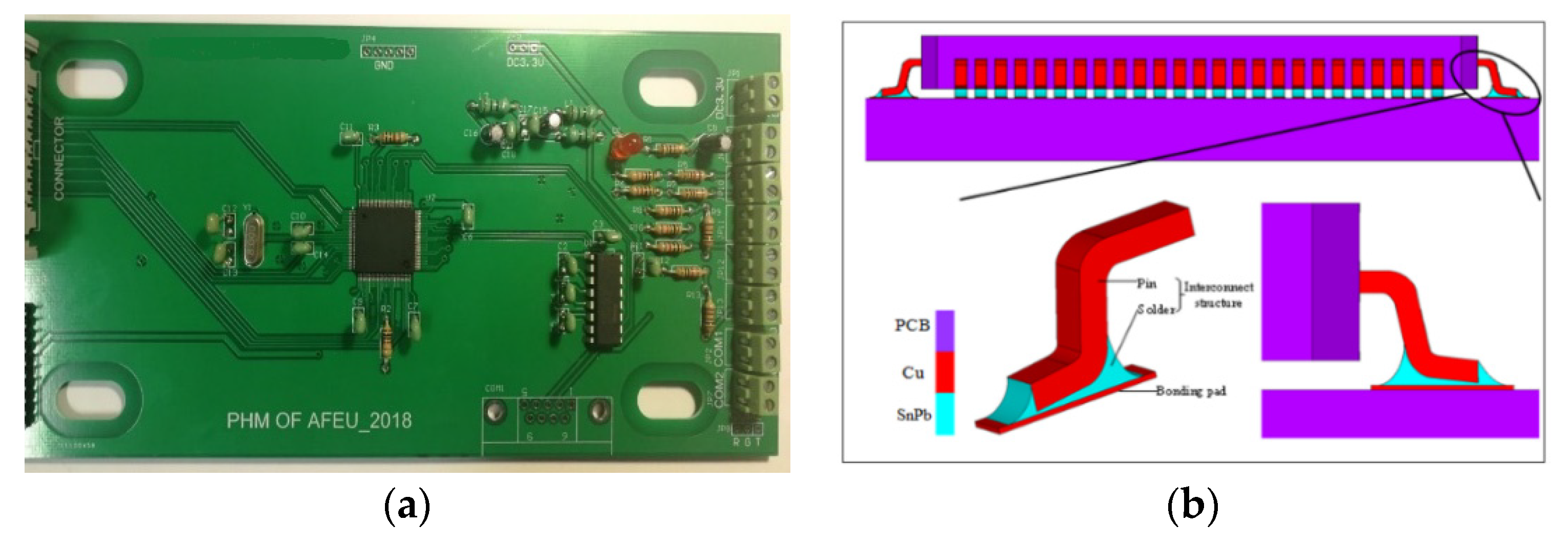
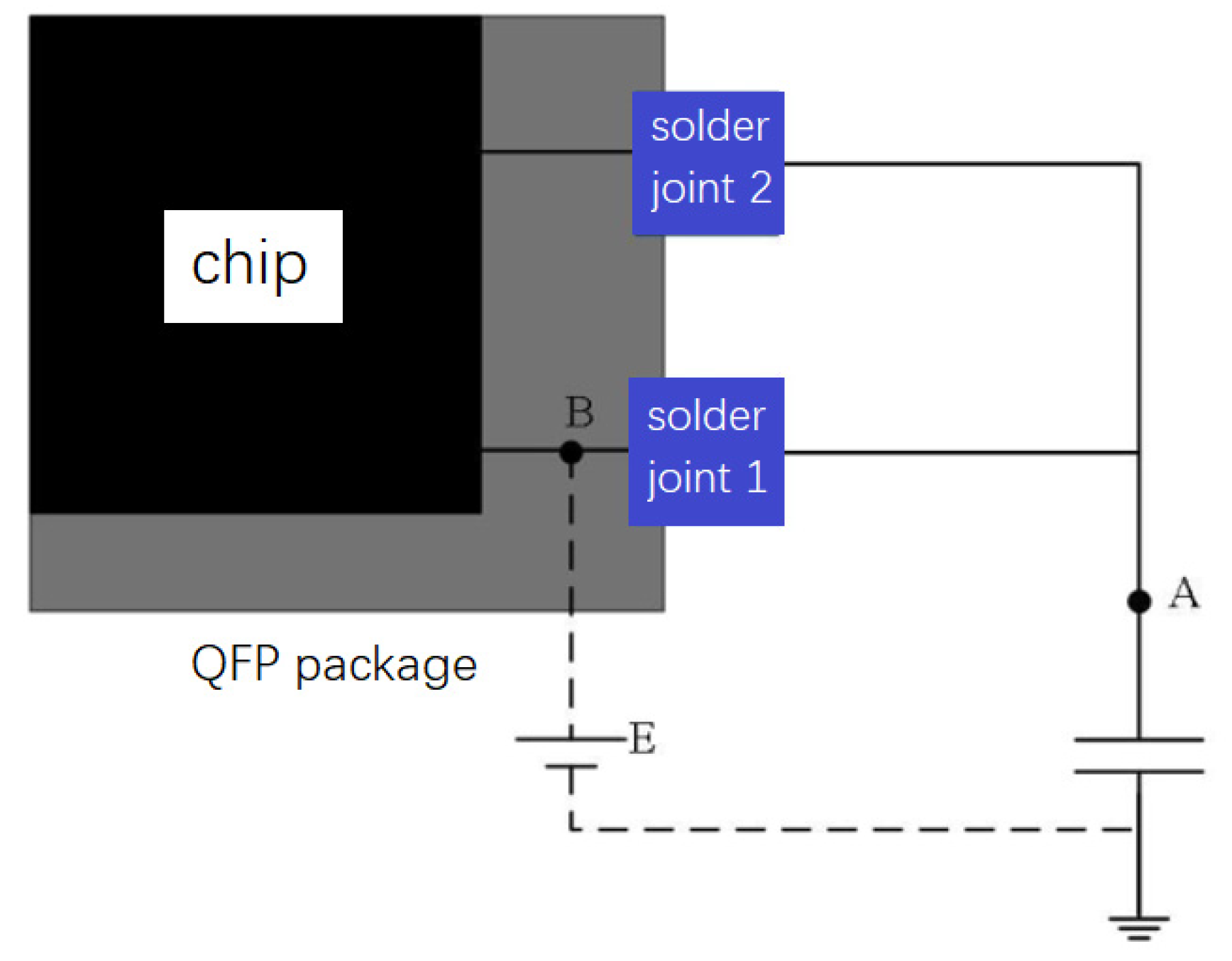
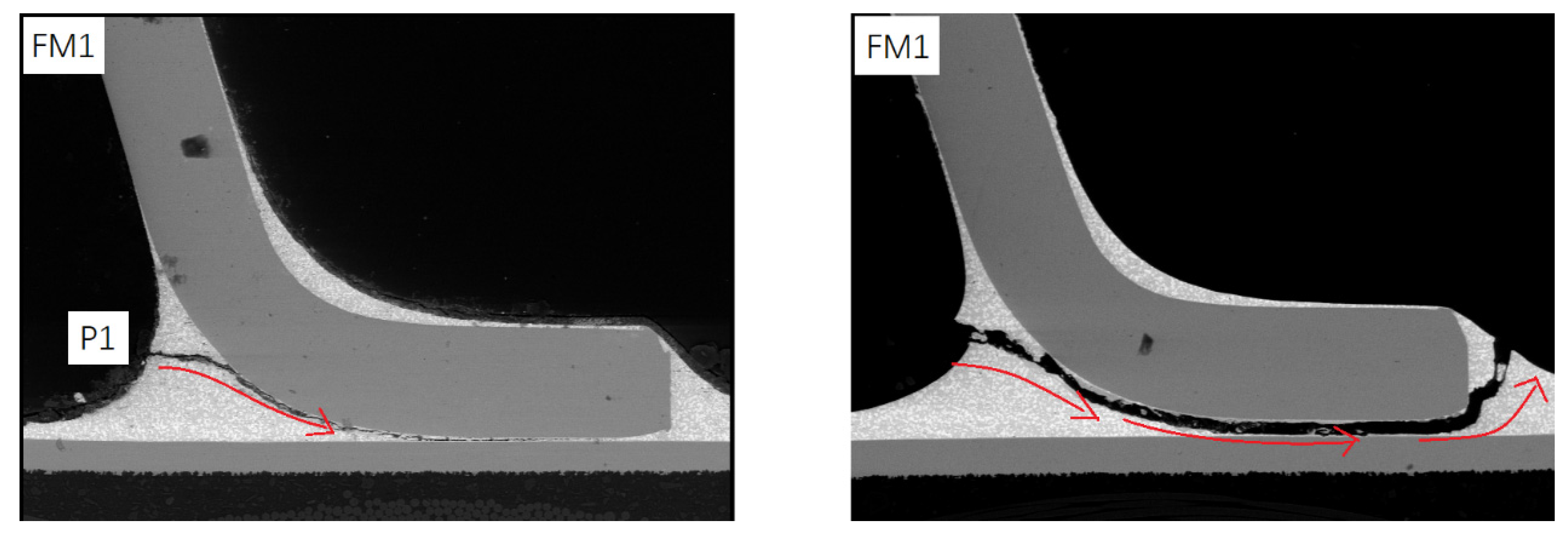
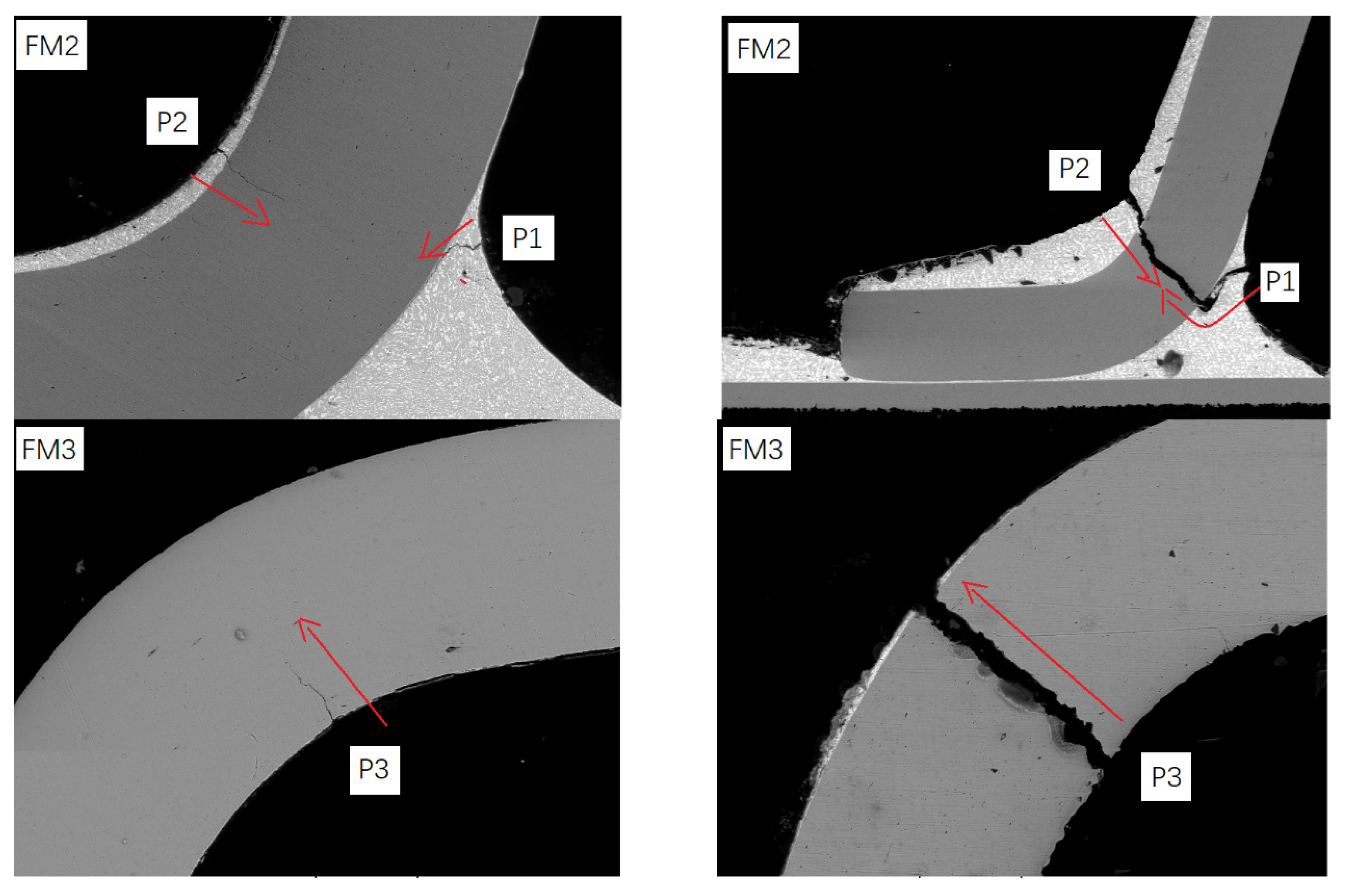
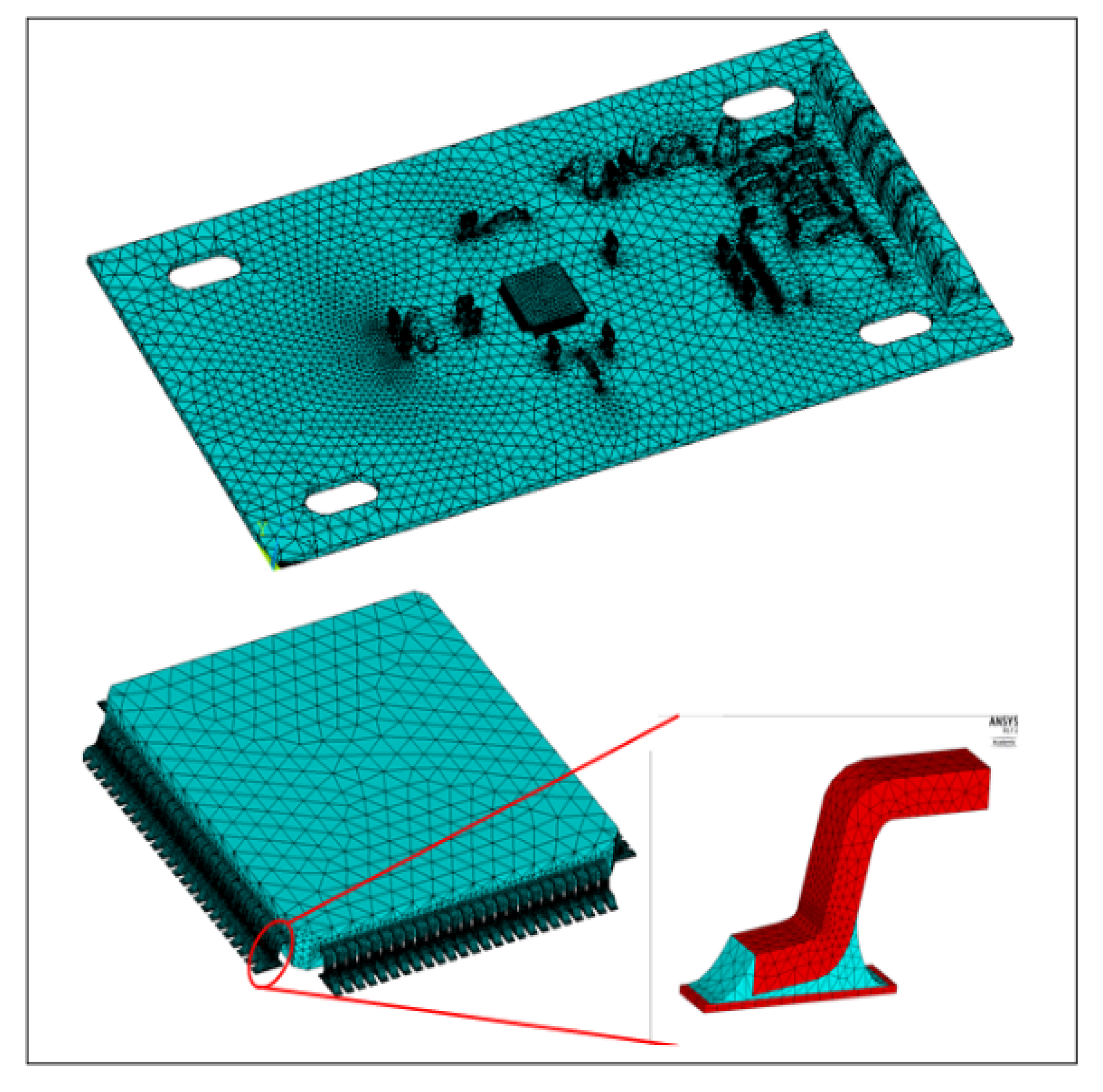
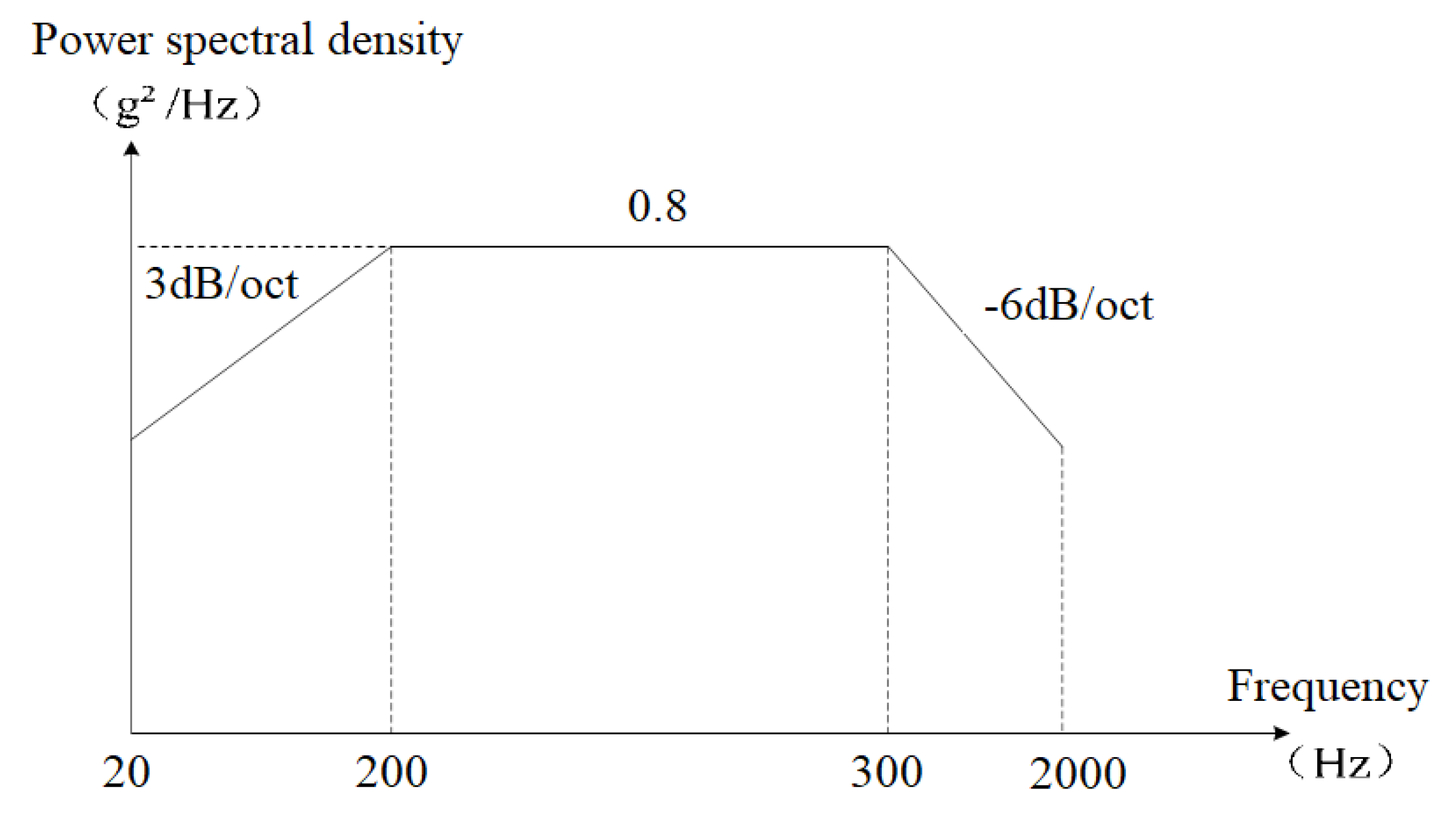
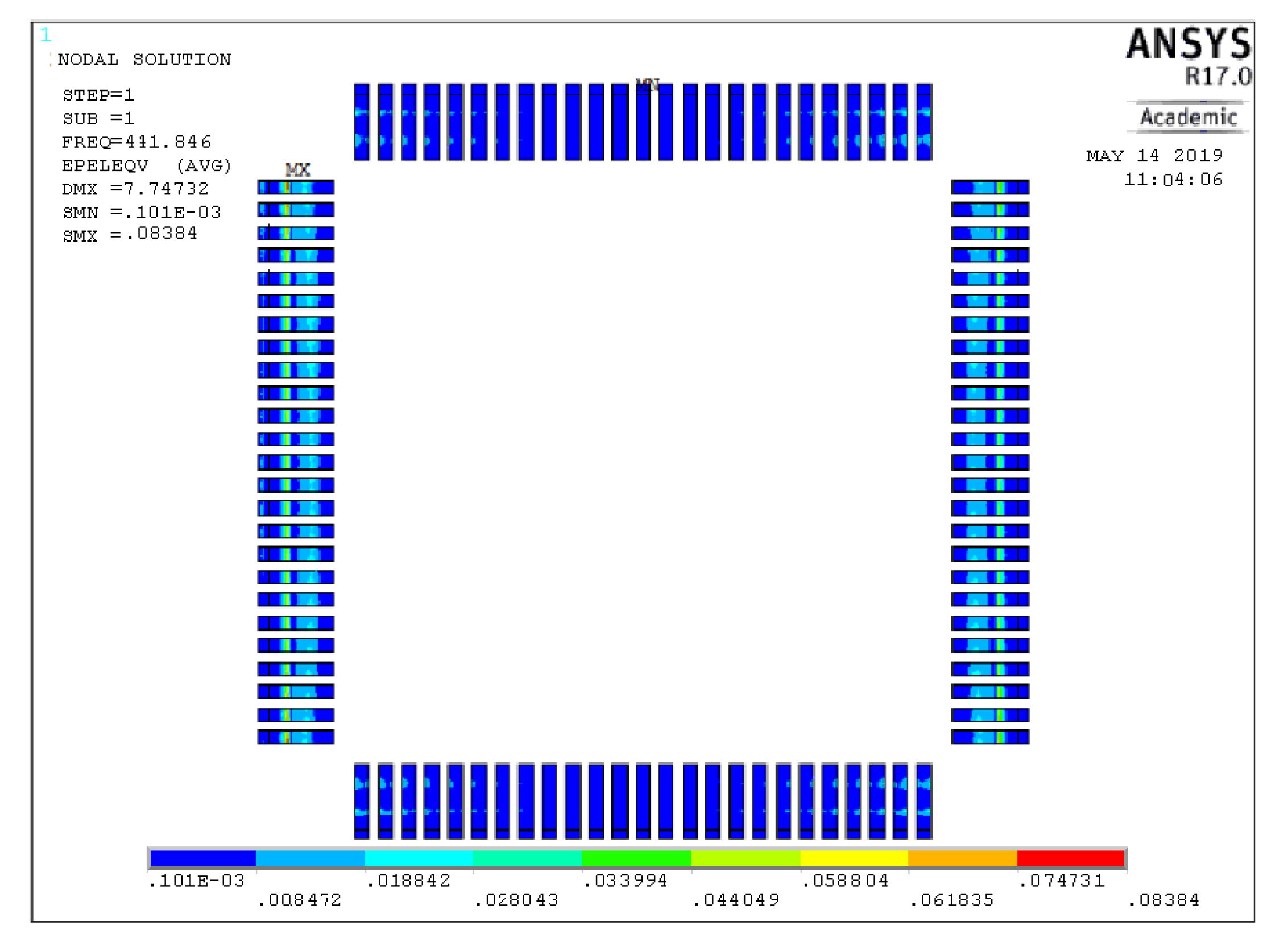
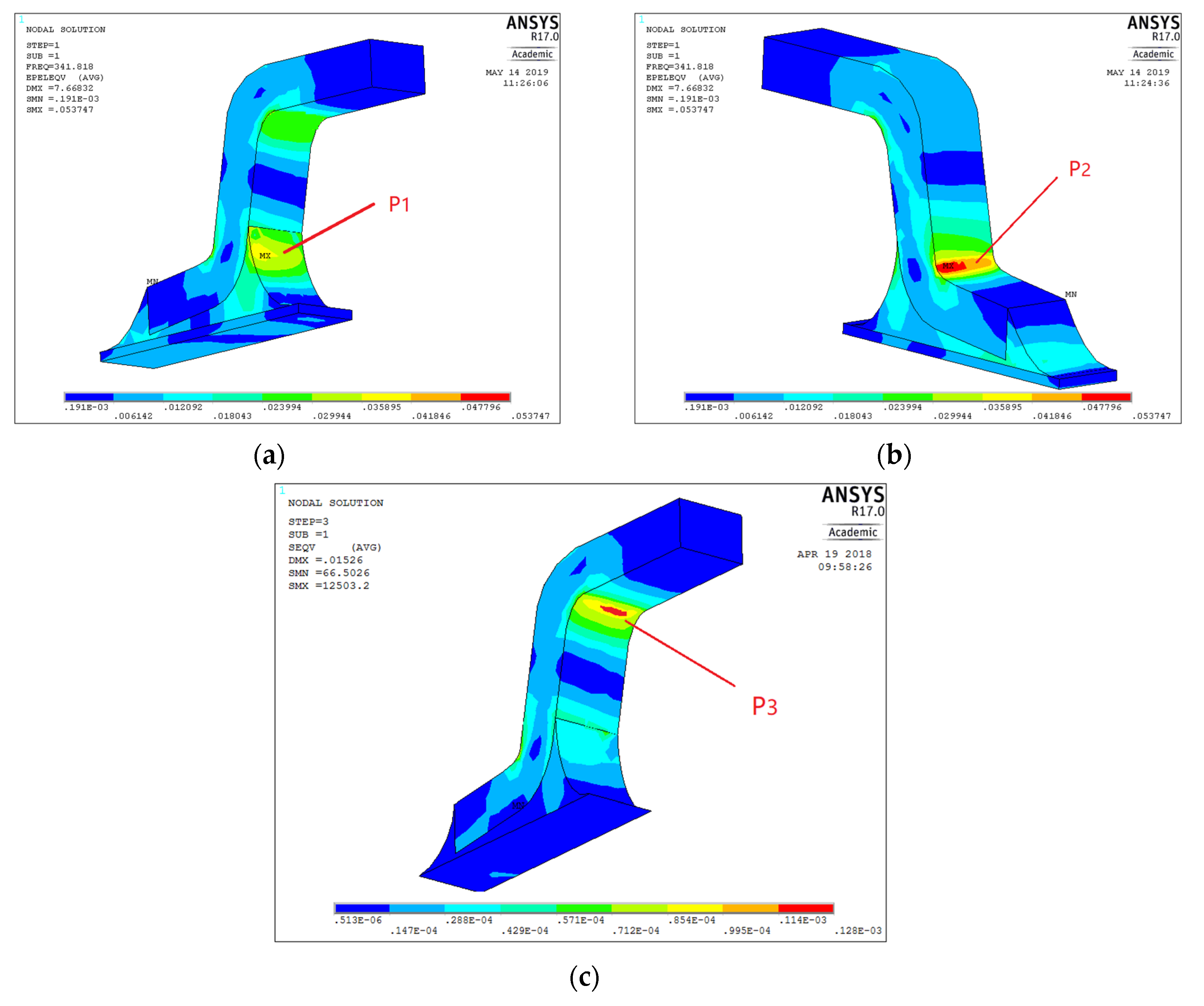
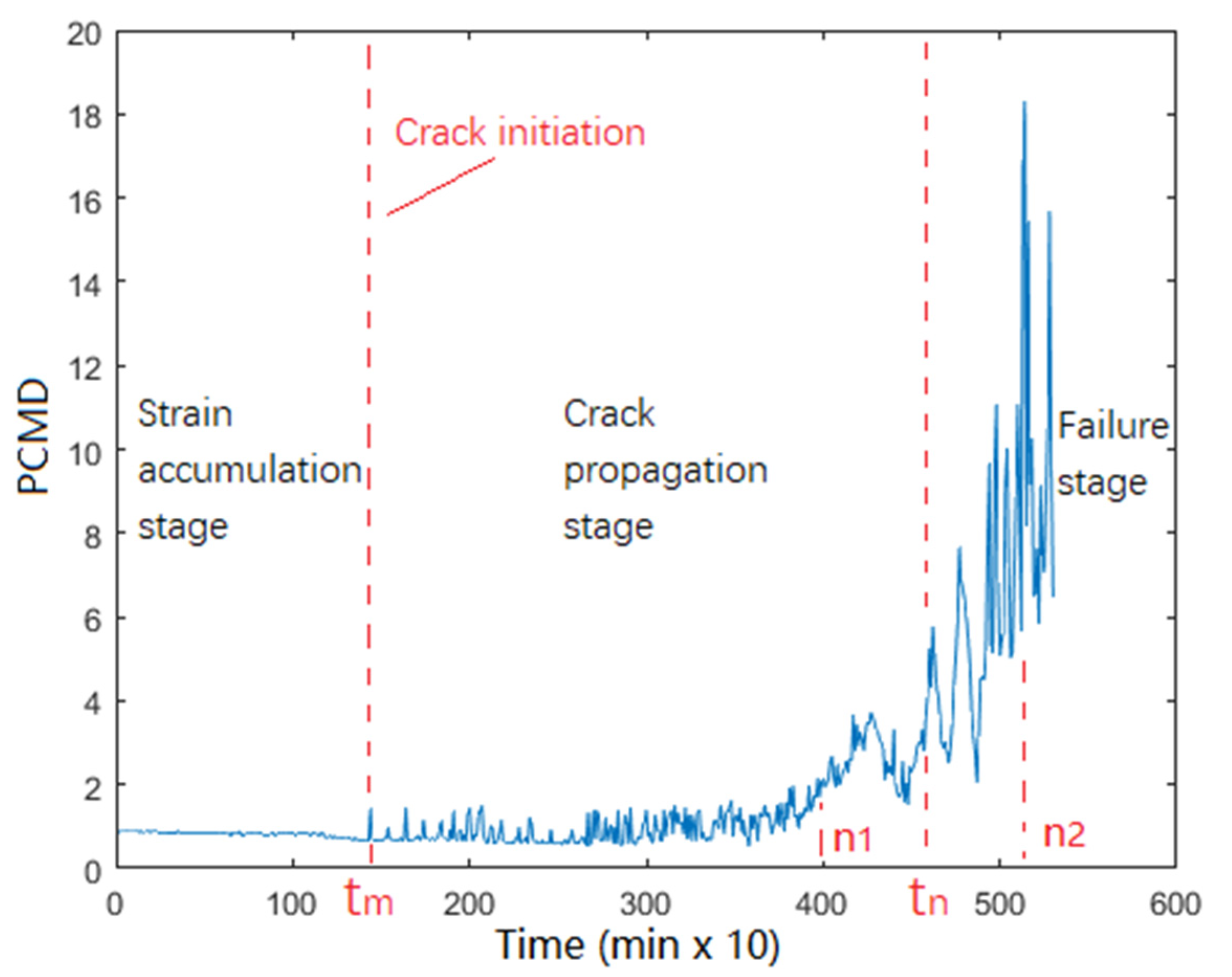
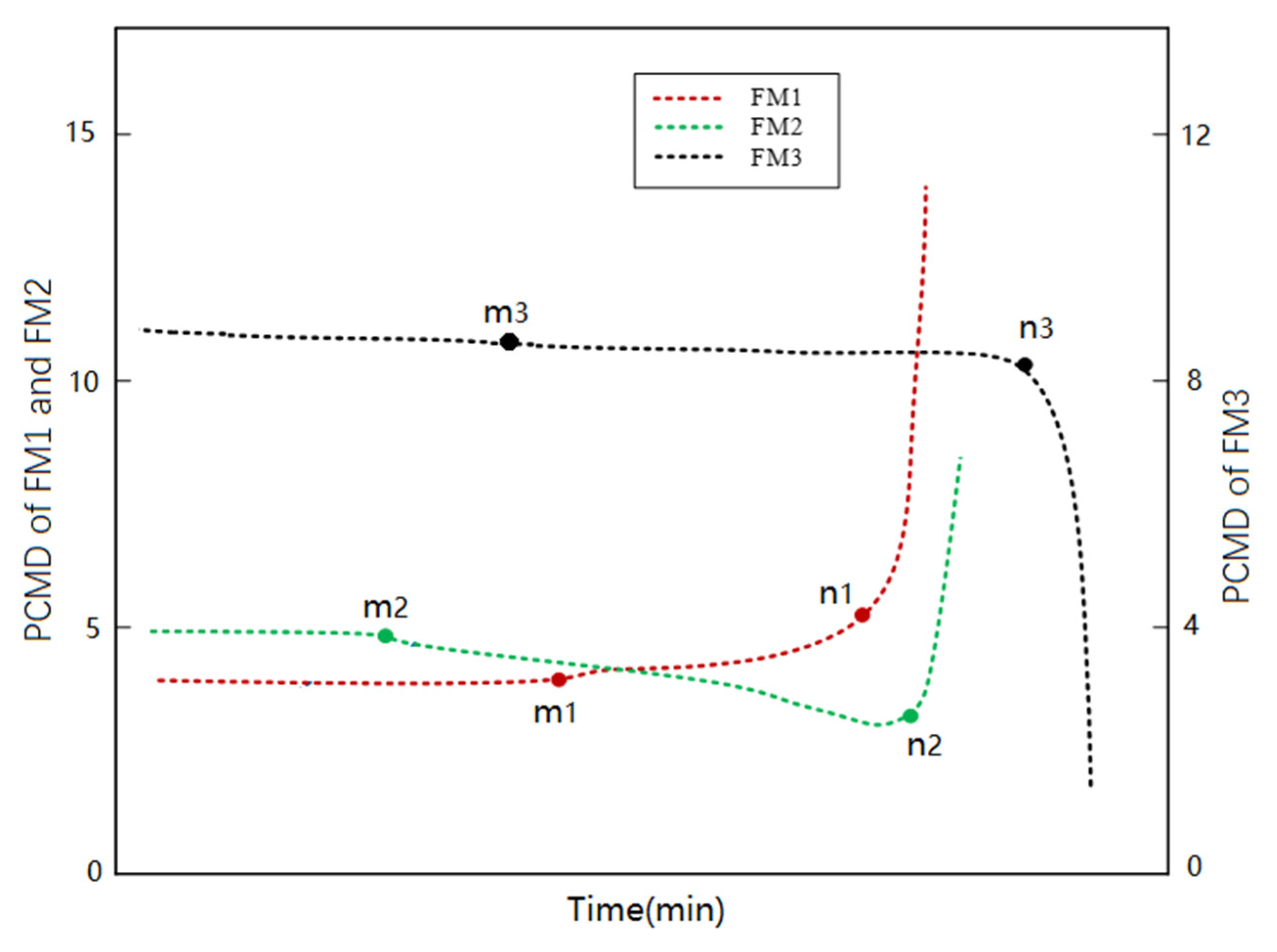
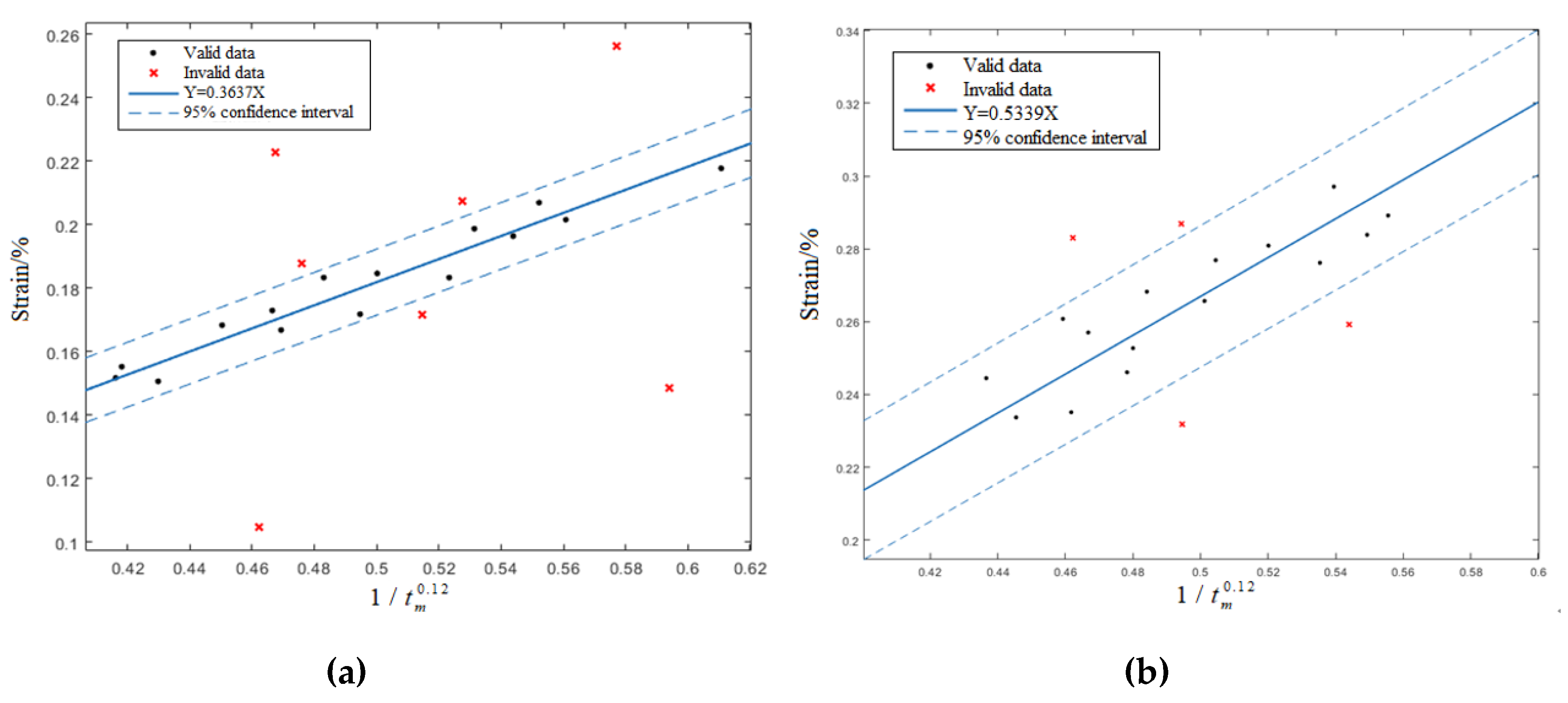
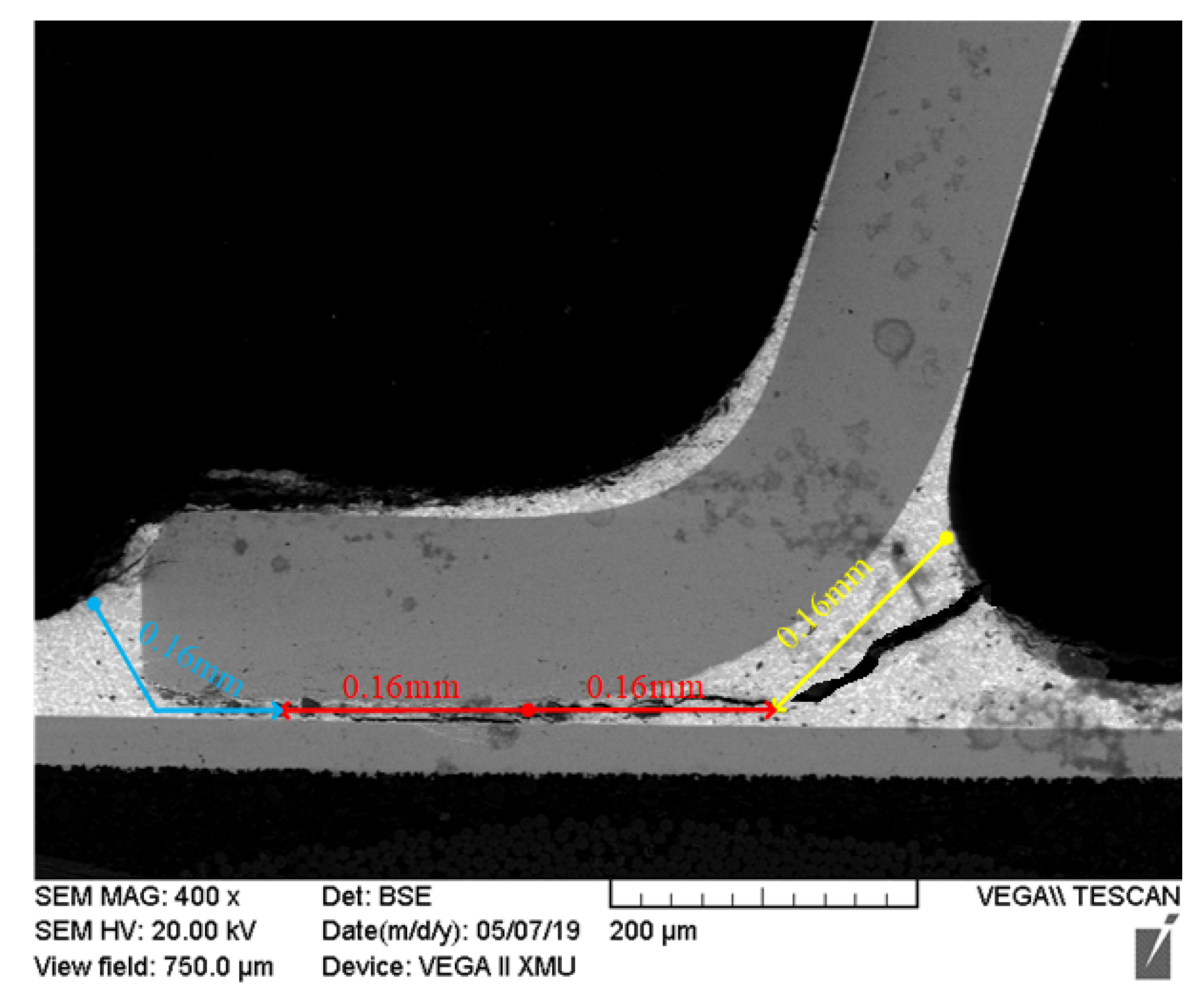


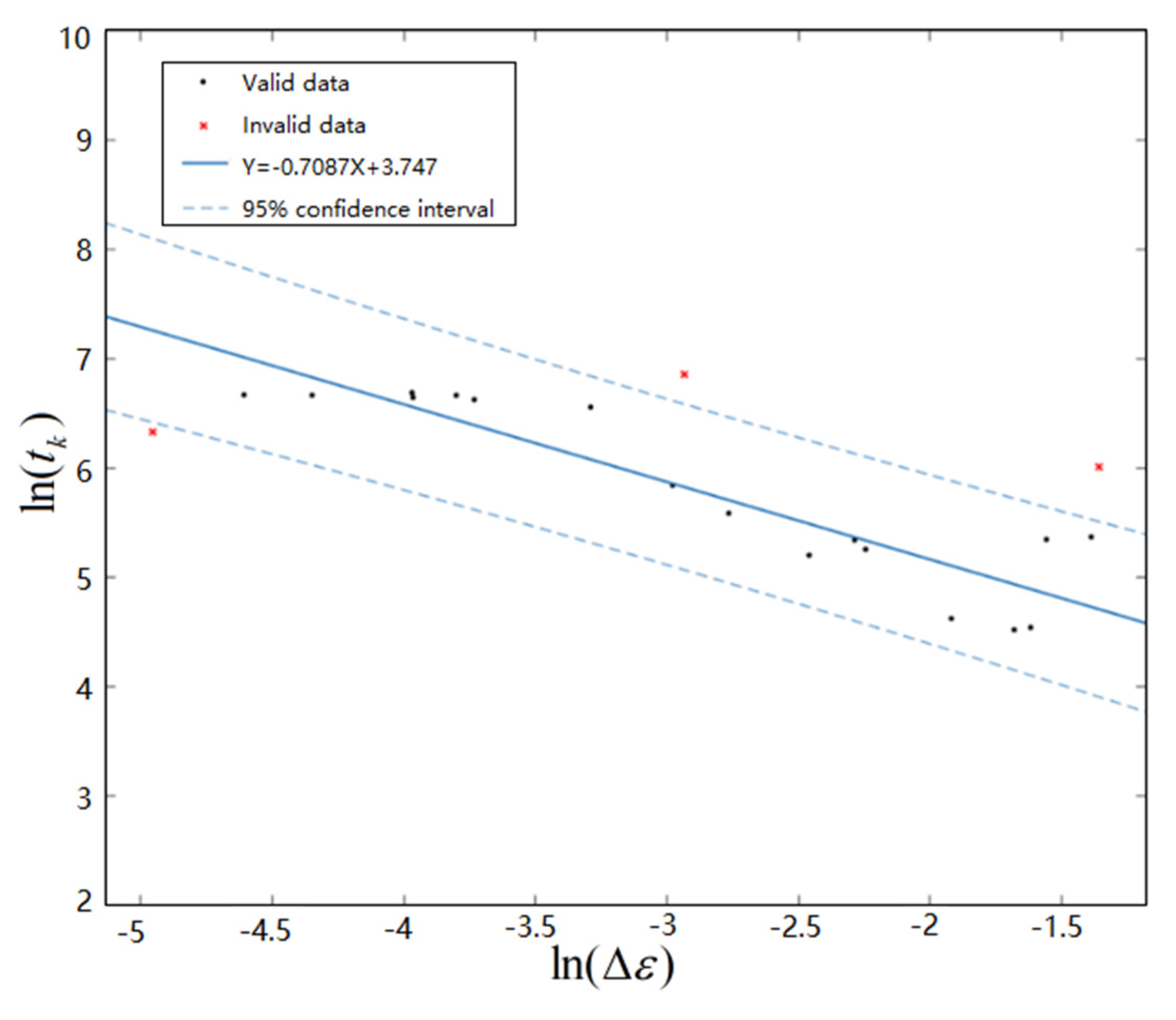
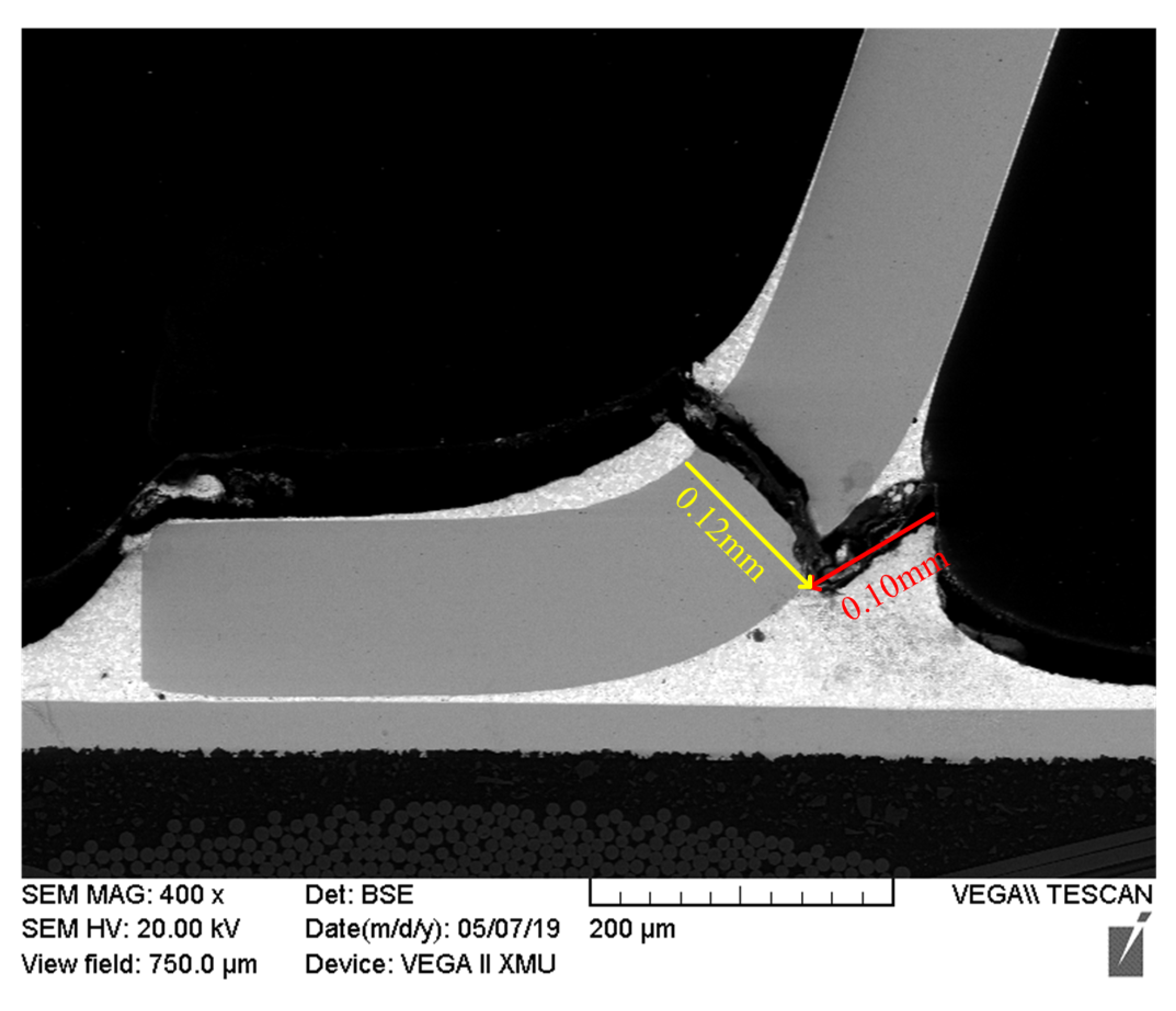
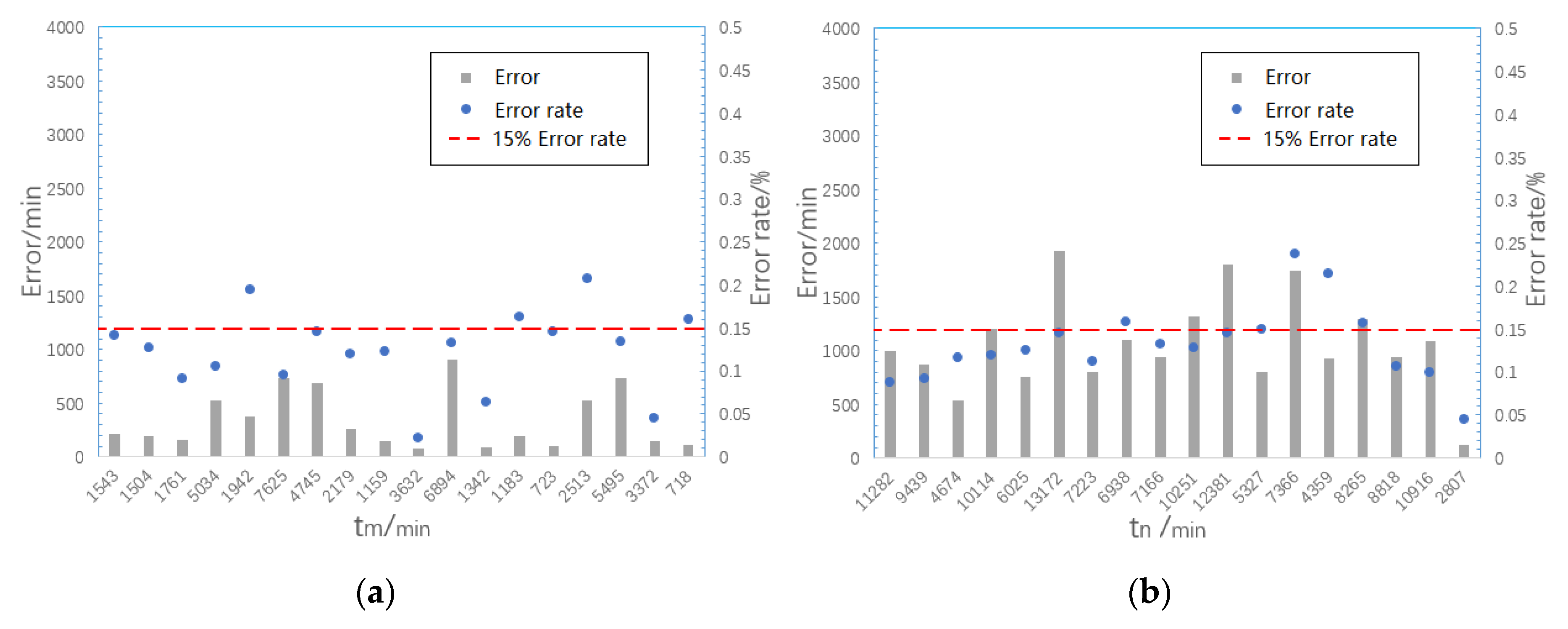
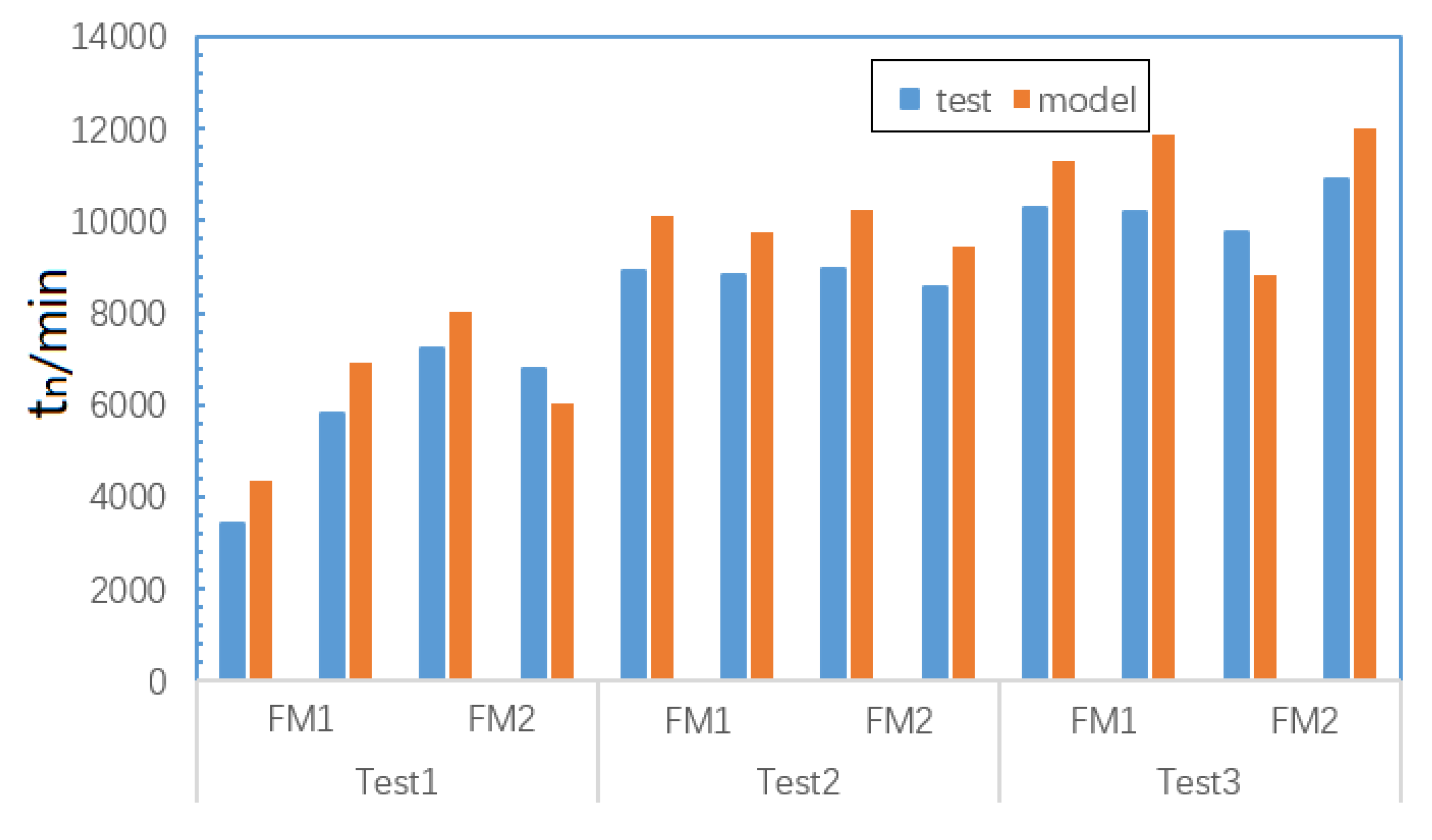
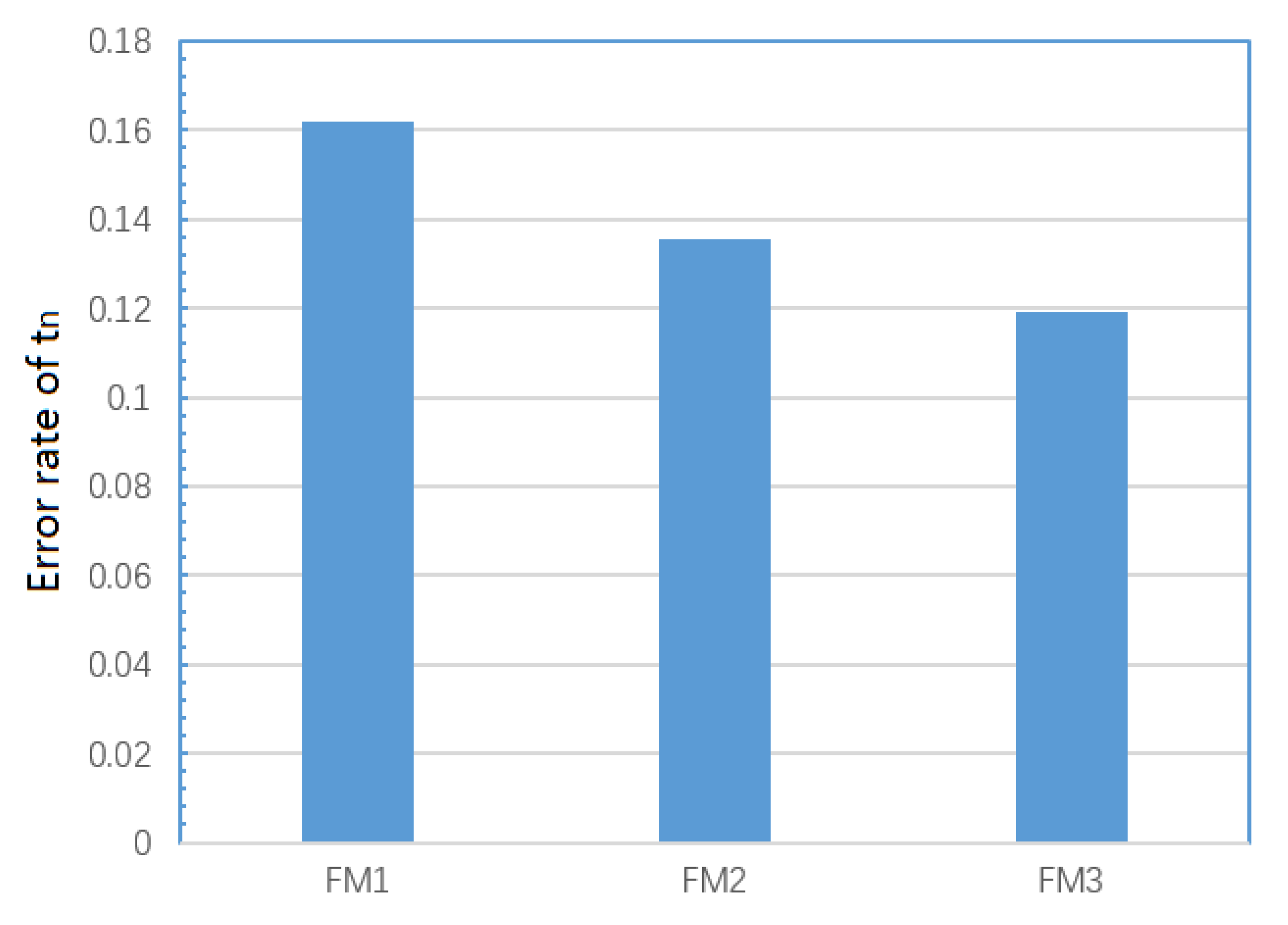
| Test Number | Temperature Load (°C) | Random Vibration Load (g2/Hz) |
|---|---|---|
| 1 | −25 | 0.8 |
| 2 | 25 | 0.8 |
| 3 | 75 | 0.8 |
| Material | Young’s Modulus (GPa) | Poisson’s Ratio | Density (kg/m3) | CET (1/K) |
|---|---|---|---|---|
| PCB(Fr4) | 22 | 0.40 | 1900 | 21 × 10−6 |
| Pin (Copper) | 141 | 0.35 | 8700 | 16.6 × 10−6 |
| Chip (Silicon) | 17 | 0.28 | 2329 | 2.6 × 10−6 |
| Solder (60Sn-40Pb) | 30 | 0.40 | 9000 | 21 × 10−6 |
| Material Parameter | Value | Definition |
|---|---|---|
| A/s−1 | 6220 | Pre-exponential Factor |
| Q/(J·mol-1) | 6310 | Activation Energy/Boltzmann’s Constant |
| ξ | 3 | Multiplier of Stress |
| m | 0.27 | Hardening Constant |
| h0/MPa | 60599 | Strain Rate Sensitivity of Stress |
| a | 1.8 | Strain Rate Sensitivity of Hardening |
| ŝ/MPa | 36.86 | Coefficient for Deformation Resistance Saturation Value |
| n | 0.022 | Deformation Resistance Value |
| /MPa | 3.15 | Initial Value of Deformation Resistance |
© 2020 by the authors. Licensee MDPI, Basel, Switzerland. This article is an open access article distributed under the terms and conditions of the Creative Commons Attribution (CC BY) license (http://creativecommons.org/licenses/by/4.0/).
Share and Cite
Li, L.; Jing, B.; Hu, J. Study on Establishing Degradation Model of Chip Solder Joint Material under Coupled Stress. Materials 2020, 13, 1813. https://doi.org/10.3390/ma13081813
Li L, Jing B, Hu J. Study on Establishing Degradation Model of Chip Solder Joint Material under Coupled Stress. Materials. 2020; 13(8):1813. https://doi.org/10.3390/ma13081813
Chicago/Turabian StyleLi, Longteng, Bo Jing, and Jiaxing Hu. 2020. "Study on Establishing Degradation Model of Chip Solder Joint Material under Coupled Stress" Materials 13, no. 8: 1813. https://doi.org/10.3390/ma13081813
APA StyleLi, L., Jing, B., & Hu, J. (2020). Study on Establishing Degradation Model of Chip Solder Joint Material under Coupled Stress. Materials, 13(8), 1813. https://doi.org/10.3390/ma13081813




